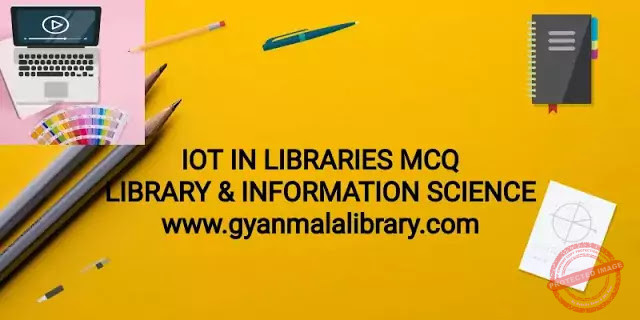INTERNET OF THINGS IN LIBRARIES
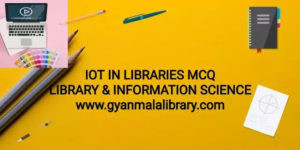
• Internet of Things may be a system of interrelated computing devices or objects which have the power to transfer the info over a network without requiring any human to human or human to computer interaction uniquely addressable, supported standard communication protocol.
• it’s an enormous network of connected things, capturing the info about the way they’re used and therefore the environment around them. • once we discuss the “Things” in IoT, these are objects not precisely identifiable.
• The sensors are utilized in the devices and objects and these feed the info to varied IoT platforms.
• Further, IoT platforms are wont to gather the pinpointed information, detect patterns.
• Thus, with the above process the IoT helps the organizations and institutions in reducing the value through improved processes efficiency, asset utilization and productivity.
Different Names of IoT
• Internet of Everything
• Smarter Planet
• Machine to Machine (M2M)
• The Fog
• Tsensors (Trillion Sensors)
• the economic Internet
• Industry 4.0
• Internet of Things (IoT)
Reasons for INTERNET OF THINGS IN LIBRARIES
Data deluge : The explosion of the quantity of knowledge collected and exchanged is one among the main reason why IoT came alive . Forecasts indicate that within the year 2015 quite 220 Exabytes of knowledge are stored. So we’d like novel mechanisms to seek out , fetch, and transmit data.
there’s decrease in energy required to work intelligent devices. The search are going to be for a zero level of entropy where the device or system will need to harvest its own energy.
Miniaturization of devices: the devices are getting increasingly smaller.
Autonomic management: the devices/systems of future will have self-management, self-healing, and self-configuration capabilities.
IPv6 as an integration layer: allows to take advantage of the potential of IPv6 and related standards.
Internet of Things Enablers
• Energy
• Intelligence
• Communication
• Integration
• Interoperability
• Standards
How are the networks changing?
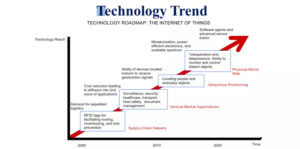
• Extensions
– More nodes, more connections
– Any TIME, anywhere + Any THING
– M2M, IoT
• Billions of interconnected devices,
• Everybody is connected.
• Expansions
– Broadband
– LTE, 5G
• Enhancements
– Smart networks
– Data-centric and content-oriented networking
– Context-aware (autonomous) systems
Architectural Trends
• the subsequent issues are important for IoT standardization
Designing Web Services
Designing Messaging Services
Designing Common Data Exchange Formats
Using Internet Protocol Layers or an IP proxy layer
• The architectural framework must incorporate all the specified aspects like scalability, flexibility, adaptability etc.
• The components, and interfaces for various building blocks like device interfaces, data formats, networking standards and protocols, service platforms and application interfaces are to be defined in IoT standards.
Sensors and Actuators
• Sensors:
– they’re mainly input components
– They sense and collect surrounding information
– Basically three types:
• Passive, omnidirectional (e.g. mic)
• Passive, narrow-beam sensor (e.g. PIR)
• Active sensors (e.g. sonar, radar, etc.)
• Actuators:
– they’re mainly output components
– They alter the encompassing .
– Some examples:
• Adding lighting, heat, sound, etc
• Controlling motors to maneuver objects
• Displaying messages • and others…
Things
• we will turn almost every object into a “thing”.
• A “thing” still looks very similar to an embedded system currently.
• A “thing” generally consists of 4 main parts:
– Sensors & actuators
– Micro controller
– Communication unit
– Power supply
• A “thing” has the subsequent properties:
– It’s usually powered by battery. this suggests limited source of energy.
– It’s generally small in size and low in cost. This limits their computing capability.
– It doesn’t usually perform complicated tasks.
• Power consumption is that the main design issue.
Communications
• A “thing” always feature communications for “team working”
• The Role of Communications – Providing a knowledge link between two nodes
• Communication type:
– Wireline (e.g. copper wires, optical fibers)
– Wireless (e.g. RF, IR). RF-based communication is that the hottest choice (and also our focus)
• Popular RF-based communication solutions:
– IEEE 802.15.4
– IEEE 802.11 (or Wi-Fi)
– Bluetooth
– Near Field Communication (NFC), e.g. RFID Communications
Networks
• The Roles of Networks
– Managing nodes (discovery, join, leave, etc).
– Relaying data packets from the source to the destination node within the network.
• Networks are a distributed system. All nodes got to perform networking related tasks.
• RF-based Network in IoT is typically a Wireless Multi-hop Network.
– Wireless Sensor Networks
– Mobile Wireless unplanned Networks
– Wireless Mesh Networks
– Vehicular unplanned Networks
– and lots of others…
• Main concern: Reliability & Performance
The Internet
• the web is a good area networking for an area network.
• the web uses TCP/IP. this suggests that things must also support TCP/IP.
• Gateway (or sink)

————————————————————————————————————————–
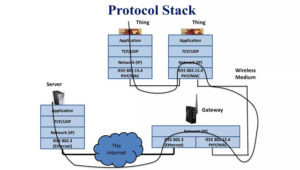
————————————————————————————————————————–
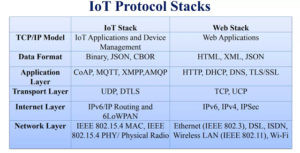
————————————————————————————————————————–
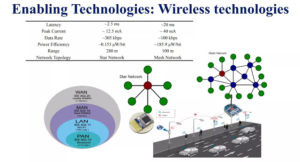
IoT Architecture
• “Physical” components / capabilities
– Sensors / Actuators
– Compute, store, communicate data
• Additional “logical” Components
– Security and dependability composition
– Time bound composition
– Cross-ownership service composition
– Policy negotiation and governance
– Federated orchestration
• Objectives INTERNET OF THINGS IN LIBRARIES
– Predictable scalability, stability, correctness, time-to-complete
IoT Threats
• Default, weak, and hardcoded credentials
• Firmware and OS are difficult to update
• Lack of vendor support for repairing vulnerabilities
• Web interface vulnerability
• Open ports are often vulnerable
• Error in Coding
• Distributed Denial-of-Service
• Physical theft and tampering Source
IoT Data-Challenges
• Multi-modal and diverse
• Noisy and unfinished
• hooked in to Time and site
• Dynamic and varies in quality
• Crowed sourced data are often unreliable
• Requires real-time analysis
• Privacy and security
• Data are often biased
IoT Governance, Privacy and Security Challenges
• The IoT’s diversity in devices, services and protocols, present challenges unseen and unprecedented within the modern communication
• Governance and Privacy Concerns
• Security Challenges
• Autonomy • Computational Constraints
• Discovery
• Trust Relationships
• It doesn’t have any international compatibility standard.
• It are often highly complex leading to failure.
• Data of Social Media utilized in Libraries
• E-platforms like e-resources subscriptions employed by the users
• Devices employed by the users like laptops, tablets, smartphones, scanners, printers etc.
• Library gate are often enabled with high-end sensors and are providers of IoT
• IoT, online connectivity to the membership counters
• Catalogues and OPACs are the potential IoTs for the libraries
• Fire detection and prevention devices also are potential IoTs of the libraries
• Mobile Apps and Mobile Referencing are supported IoTs
• Tracking movement of Resources and Inventory in Libraries
• Assistive Technologies utilized in Libraries • Virtual and Digital Libraries are supported IoTs
• Reduced safety for users.
• Internet of Things device may take hold of life in due course of your time with increasing AI technology
Potential Areas of IoT in Libraries
• Library automation software
– LMS
• Library management tools
– all the applications
• Digitization technology
– digital libraries and virtual platforms
• Tools for search- Discovery and Federated Search provided
• Access to e-resources and publisher content
• Preservation and Digitization platforms
• Internet and Wi-Fi of Libraries
• Library websites and other electronic marketing tools, including social media
• Mobile Applications employed by Libraries
• Other digital means of communications like SMS, emails etc
Conclusion
• Libraries are now using Magic Mirror consisting of camera, sensor with Wi-Fi enabled provides interaction between people and computers to record the info of the users
• Pressure pad sensor consisting of a skinny sheet sensor pad enabled with Wi-Fi technology is connected to processing unit which records and controls the systems and users activities.
• Cloud based applications also are employed by the libraries which are attached to IoT apps
• Mobile apps are now wont to have the virtual tour of the library on their mobile devices thus are often supported IoT
• Online mobile apps are wont to keep and track the supply of the book on the respective shelves or check the opposite resource availability despite the situation wherever they’re . These also are connected to IoTs to supply the info .
• Smart books, gaming, augmented reality, and object-based learning are have potential for IoTs in Libraries.
References
Source: IBM, what’s the web of Things? https://www.ibm.com/blogs/internet-of-things/what-is-the-iot/
Source: Tata Consultancy Services. ttp://gisfi.org/pdf/june_21_23_10/Internet_of_Things.ppt
Source: University of Surrey. IoT, http://personal.ee.surrey.ac.uk/Personal/P.Barnaghi/teaching/EEEM048/2015/EEEM048_Lecture1_Introduction.ppt
Re -Source: university of Surrey. IoT, http://personal.ee.surrey.ac.uk/Personal/P.Barnaghi/teaching/EEEM048/2015/EEEM048_Lecture1_Introduction.ppt
Source: LOGANATHAN V, Welcome to the Workshop on IoT & Cloud Computing the Coexistence . Available at https://slideplayer.com/slide/13103760/ and http://www.ismuniv.com/wp-content/uploads/2015/12/coexistance.ppt
http://ftp.onem2m.org/Meetings/TP/2015 meetings/20150720_TP18_Philadelphia/TP-2015-0764-ITU-T_presentation_to_oneM2M_SC27.PPT
Source: Rudra Datta, NCSU . Available at http://dutta.csc.ncsu.edu/iot_spring17/wrap/architecture.ppt
Source: Christopher Giles, Governance Risk Compliance Specialist, the web of Things (IoT) Security Considerations for education . https://www.utdallas.edu/infosecurity/files/IoT-by-UT-Dallas-022416.pptx
Source: Kizza , Chapter 24: Internet of Things (IoT): Growth, Challenges and Security: Guide to network Security https://www.utc.edu/faculty/joseph-kizza/docs/guide4notes/chapter24.ppt
Source: Bansal, Alka; Arora, Dipti; and Suri, Alka, “Internet of Things: Beginning of latest Era for Libraries” (2018). Library Philosophy and Practice (e-journal). 2081. http://digitalcommons.unl.edu/libphilprac/2081
Source: Ashwini Nag1 and Dr. Khaiser Nikam. Internet Of Things Applications In Academic Libraries. International Journal of data Technology and humanistic discipline . ISSN 2349-235X Volume 5, no 1 (2016), pp. 1-7. https://www.ripublication.com
